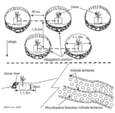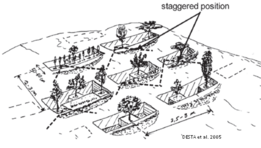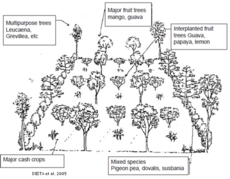Overview
► Back to the overview "Mitigation and Intervention Techniques Related to Micro-hydro Power (MHP) Projects"
Agro-forestry, Forage Development and Forestry
Area Closure
| Objectives: Strip cropping is a cropping practice where strips of two or more crops are alternately established on the contour or, it is a system of establishing more than one crop in alternate strips following a contour pattern for the purpose of erosion control, crop diversification, and decrease the risks associated to the use of single crops only. This cropping system is designed as a defence mechanism against soil erosion in areas where the cropping system is dominated by row/sparsely growing crops that exposes the ground to erosive forces. For instance, crops like sorghum and maize are susceptible to erosion and need to be grown alternately with soil conserving crops.
|
|
Microbasins (MBs)
- Objectives: MBs are small circular & stone faced (occasionally sodded) structures for tree planting. Are suitable for medium and slightly low rainfall areas, stony areas and shallow soils. Based upon experience they are not very effective in low rainfall areas (where trenches, eyebrows, etc. are preferred).
|
|
Eyebrow Basins (EBs)
- Objectives: EB are larger circular and stone faced (occasionally sodded) structures for tree and other species planting. Based upon experience they are effective in low rainfall areas to grow trees and harvest moisture. Can be constructed in slopes above 50% for spot planting. Controls runoff and contribute to recharge of water tables.
|
|
Herring Bones (HBs)
- Objectives: HBs are small trapezoidal structures (called also A structures) for tree and other species planting. HBs are suitable for both dry and medium rainfall areas, and medium soil depth. Based upon experience HBs are most effective in medium/low rainfall areas (500-900 mm). Can be constructed only on slopes < 5% and soils > 50 cm depth
|
|
Micro-trenches (MTRs)
- Objectives: MTRs are rectangular and deep pits constructed along the contours - main purpose and effects are same as for trenches. Can support the growth of trees, shrubs, and cash
crops. Can be constructed on slopes 3-30% max. gradient and soils at least 50 cm depth.
|
|
Trenches
| Objectives: Trenches are large and deep pits constructed along the contours with the main purpose of collecting & storing rainfall water to support the growth of trees, shrubs, cash crops and grass or various combination of those species in moisture stressed areas (350-900 mm rainfall). Trenches can have FLEXIBLE DESIGN, to accommodate the requirements of different species. Therefore they can suit what the farmer want to grow. Trenches collect and store considerable amount of runoff water, thus vegetation grows faster and vigorous. Trenches protect cultivated fields located downstream from flood and erosion. Part of the water captured by the trenches reaches the underground aquifer. Therefore, water tables are recharged and supply springs and wells with good quality water and for a long period of time.
|
|
Improved Pits (IP)
- Objectives: IPs are square shaped water collection pits constructed along the contours with a plantation pit in front of the main water storage pit - main purpose similar as micro-trenches. IP support the growth of trees and fodder shrubs, and can be used for cash crops like coffee. They are effective in medium and low-medium rainfall areas (above 600-700 mm).
|
|
Multistorey Gardening
- Objectives: Multi-storey gardening is a way of planting a mixture of crops, shrubs and trees of different heights and different uses: food crops, cash crops, fruit trees, woody perennials, and forage plants. It makes the land more productive and improves soil fertility, reduces temperature, provides shade, and increase family income, particularly during a period of drought.Fields close or within homesteads can be converted into diversified productive units (decreasing risk factors, increased income, etc.). Such systems have higher resistance to pests and insects. A broad network of such homesteads can extend into open fields and constitute large erosion-protected zones or a “web” of green fences and mutually supporting units.
|
|
Seed Collection
- Objectives: Seed collection is divided into two:(1) Seed collection of tree species: mostly for indigenous trees to grow in nurseries for specific and multipurpose uses. (2) Legume shrubs and grass seeds: mainly legume shrubs seeds and grass/plant species that can be used for stabilization, homestead plantations, grazing lands improvement, support to nurseries, fencing, gully control. This activity is especially valuable for grass seeds collected outside the nursery areas and seed multiplication centers, particularly native grasses of particular value for their adaptability to local conditions. The collection of local seeds is an effective way to protect valuable planting materials from extinction and to replenish depleted areas with materials collected from other areas.
|
|
Further Information
References
- DESTA, L. et al. (2005): Part 1: Community Based Participatory Watershed Development: A Guideline. Addis Ababa: Ministry of Agriculture and Rural Development.























